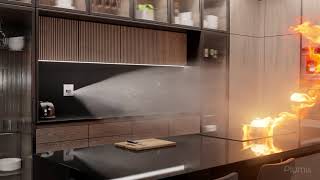What are electronically controlled water mist nozzles for fire protection?
The concept of using an electronic means of activating an automatic water fire suppression system is by no means new. In 2012, Kopylov and colleagues published a paper on ‘The Advantages of electronically controlled sprinklers (ECS) for fire protection of tunnels’. In 2017, Magnone and colleagues presented a paper on ‘Warehouse protection of exposed expanded Group-A plastics with electronic sprinkler technology’, at the 16th International Conference on Automatic Fire Detection in Maryland, USA. More recently, the 2023 edition of the American Standard for Water Mist Fire Protection Systems (NFPA 750) recognises electronically operated water mist nozzles as a subcategory of automatic water mist nozzles:
3.3.25.1 Automatic Water Mist Nozzles. Nozzles that operate independently of other nozzles by means of a detection/activation device built into the nozzle.
3.3.25.2 Electronically-Operated Automatic Water Mist Nozzle. Nozzles that are normally closed and operated by electrical energy that is initiated and supplied by fire detection and control equipment.
Electronically operated nozzles are also referenced within the definition of the European watermist standard, EN 14972-1. As per clause ‘4.11.5 Electrical detection and activation’, which is common for local application systems. The only difference is that local application systems typically use open nozzles with all nozzles discharging simultaneously, and some electronically controlled nozzles can switch particular nozzles from closed to open upon detection.
Fire test protocols
The fire test protocols applied to these nozzles are no different to those applied to other automatic sprinkler or watermist nozzles. The required fire load and performance are defined by the application. The only difference is that the electronic activation (e.g. detection and the algorithm used on the fire test) must be documented in the Design Installation and Operation Manual (DIOM) and used in practice.
As per EN 14972-1 clause ‘4.8.5.2 Fire detection and fire alarm system and activation system’:
‘When a specific fire detection is defined in the DIOM manual, based on the results of the fire tests, it shall be used to actuate the water mist system in actual installations.’
Additionally, if there are any key parameters, or limits of applicability stipulated in the manufacturer’s DIOM they must be validated in fire tests. For example:
- Maximum and minimum distance from fire load to nozzle or between nozzles
- Limits of performance with respect to obstructions
- Operation with minimum and maximum nozzle spacings
- Operation with minimum and maximum number of nozzles discharging
Component and System Approval
The approval of an electronically controlled water mist fire suppression system should include the approval of the system as well as of components. Testing should include, but is not limited to:
- the verification of reliability and performance of electronic PCBs, components and algorithms, as per established electronic control system, detection system and alarm panel approval protocols.
- the validation of the algorithm that decides which nozzles activate and when, as well as the verification of the avoidance of false positive activations.
- ‘stress’ tests of the algorithm to evaluate whether the algorithm performs as intended in worst-case scenarios such as ambient temperatures, different types of fires or the use of the maximum number of nozzles/components to result in maximum communication traffic/system delay.
Dry or wet pipe
Electronically operated nozzles can be wet or dry pipe. Wet pipe systems are the most common with the piping constantly filled with water and pressurised. Dry pipe systems are not constantly filled with water. Instead, the water is held behind a dry pipe valve usually some distance away from where the nozzles are located. Electronically operated nozzles for dry pipe systems can compensate for the time delay necessary to fill the pipe with water with early activation. This should be validated in the fire testing and documented in the DIOM. As per clause ‘4.9.4.4.2 Dry pipe systems’ of EN 14972-1:
‘The maximum acceptable discharge-delay of a dry pipe system shall be in accordance with the DIOM manual (as demonstrated in the fire test) and validated for the installation’.
Early reliable detection and activation
A report on a recent study on the causes of fire fatalities and serious fire injuries in Scotland and potential solutions to reduce them suggested that “More needs to be done in terms of reliable early detection and suitable intervention, to either delay the development of the fire or to notify people – using technology – so they can take suitable action at the early stages of the fire.” Automatic water fire suppression systems (AWFSS), such as sprinklers and watermist, provide a means to protect lives and property by both detecting a fire and then controlling or extinguishing it.
Shielded fire scenarios present a challenge to suppression systems when compared to cases in which the fire is open to the suppression medium. In the report by BRE (no. 204505), it was noted that “Sprinkler protection was not found to be a complete panacea, slow-growing and shielded fires can be a problem”.
There are several motivations behind the development of automatic nozzle watermist systems as an alternative to existing suppression methods. The first is that, by adopting a method of activation linked to a smoke detector and an IR sensor, a quicker response time might be expected compared to a conventional system, which is typically reliant on substantial development of heat in the fire plume and subsequent heat transfer to the sensing element. By providing quicker detection and system activation, this has the potential to suppress the fire earlier in its development, reducing the hazard for occupants. Another motivation relates to the introduction of finer water droplets and thus a lower rate of water discharge, minimising any requirement for large water tanks to support the system’s operation. This approach also provides greater flexibility for the retrofitting of systems, enhancing the safety of existing buildings. Finally, false alarms can be reduced by adding greater sophistication to activation than just a single-point heat detection (e.g. a glass bulb).
Fire engineering research has shown that electronically controlled fire suppression systems can have an effective RTI of 20 m½s½ and C factor of 0.25 m½s-½. The measured activation times can be 2.0 to 13.7 times faster than a concealed sprinkler, this significantly impacts its ability to aid means of escape.
Targeting
Electronically operated nozzles are by their very nature targeted. This is because closed nozzles can be opened electronically. An algorithm tells the system how many nozzles must activate to cover a specific portion of the room or the fire load, and potentially, surrounding areas to aid suppression by pre-wetting. Targeting may take several forms, it can be through the directionality of the nozzle or by the activation of a set or variable proportion of an array of nozzles, or both. Whatever the choice, the principle of operation must be detailed in the DIOM manual and that principle is validated on a series of fire tests for the application type being protected.
Electronically operated nozzles are not exclusive to water mist and not exclusive to residential or commercial applications. An electronically operated system may be initiated by a fire detection and alarm (FD&A) system or it may even replace the need for an FD&A.
Case study
Automist is an example of a product in this category because it uses thermal sensing and an intelligent algorithm to detect a fire as opposed to a thermally activated mechanical element. In the event of a fire, Automist is triggered automatically by a ceiling-mounted smoke sensor. Automist’s wall-mounted nozzles then scan the room to look for temperature changes indicating a fire. If danger is detected, the pipes are filled with water and the best-positioned nozzles target the fire and watermist cools the fire zone.
Read more - What is Automist Smartscan Hydra?


